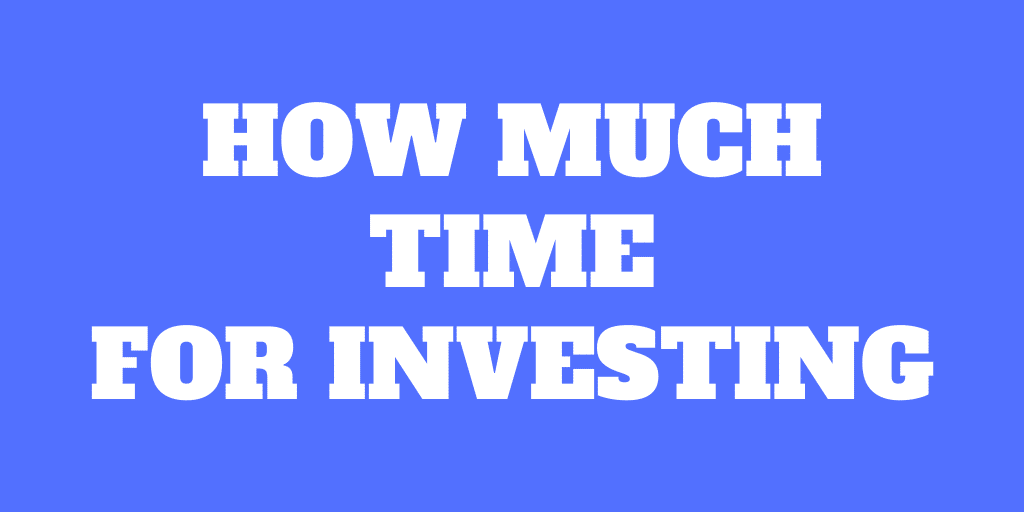(Disclosure: Some of the links below may be affiliate links) Many people do not invest because they think it is too much work or takes too much time. Investing may indeed take a little work and time to get used to it at the beginning. However, once you are used to, investing in the right way takes very little time and effort each time. So, in this article, we are going to see exactly how much time investing takes. I will start talking about investing yourself (DIY Investing), but I will also cover investing through a Robo-advisor to see the difference in time invested. If you are not investing because you think it takes too much time, you should know better by the end of this article. The learning phase Where investing by yourself (DIY investing) takes the most time, work and effort
Topics:
Mr. The Poor Swiss considers the following as important: Investing
This could be interesting, too:
Lance Roberts writes CAPE-5: A Different Measure Of Valuation
Lance Roberts writes CAPE-5: A Different Measure Of Valuation
Lance Roberts writes Estimates By Analysts Have Gone Parabolic
Lance Roberts writes The Impact Of Tariffs Is Not As Bearish As Predicted
(Disclosure: Some of the links below may be affiliate links)

Many people do not invest because they think it is too much work or takes too much time. Investing may indeed take a little work and time to get used to it at the beginning. However, once you are used to, investing in the right way takes very little time and effort each time.
So, in this article, we are going to see exactly how much time investing takes. I will start talking about investing yourself (DIY Investing), but I will also cover investing through a Robo-advisor to see the difference in time invested.
If you are not investing because you think it takes too much time, you should know better by the end of this article.
The learning phase
Where investing by yourself (DIY investing) takes the most time, work and effort is during the learning phase. As a DIY investor, you will have to make several important decisions, and each of these decisions requires some amount of research.
First, a DIY investor would need to choose how to invest:
- Invest in active funds or passive funds
- Invest in mutual funds or invest in Exchange Traded Funds (ETFs)
- Invest globally or only in sustainable companies
If you are on this blog, you are likely investing passively with Exchange Traded Funds (ETFs). I believe this is the most efficient way of investing, especially in Switzerland. You can also invest passively in mutual funds if you have access to good mutual funds in your country.
Then, you will need to choose a portfolio. And this step can definitely take a long time. It is an important decision, and you should plan for the long term. I plan to keep investing in my portfolio for several decades, so it must be a good fit for my future.
Choosing a passive portfolio involves choosing the indexes you want to invest in. Then, you will have to find a fund or ETF that replicates this index for each of the indexes.
If you keep your portfolio simple, it will not be that difficult. But you still need to decide and be convinced that this is a good investing strategy for your future.
Once you have chosen your portfolio, you will need to decide on a broker unless you have decided to go with mutual funds. There are many options available, so it is not trivial to choose a good broker. However, there are not that many good options. So, it is important to choose properly. You want to minimize the fees and have access to all the ETFs you need.
It is tough to estimate how much time, work, or effort this first learning phase would take. But from my experience, I would say that most people need between one week and one month of thinking about it to get to a decision.
This phase is definitely what takes time for a DIY investor.
The investing phase
Once you are done with the basic decisions, you can go into the investing phase. This phase will last a very long time, decades probably.
But once you get started, investing does not take much time, work, or effort. It is actually really straightforward. But many people think that investing itself is not difficult.
I recommend investing once a month. This means you only need to do something about your investments once a month. There is really no need to do anything else during the month.
Here is what you will need to do each month:
- Transfer money from your bank account to your broker account. You can automate this step if you want to.
- Convert CHF into USD if necessary.
- Buy shares of one ETF.
The first step will not take you more than two minutes. But depending on your bank, you may have to wait one business day to get the money on your broker account. Some people automate this step with a recurring operation on their bank account.
The second and third steps will not take you more than five minutes per month either. And this includes the time it takes to connect to your broker account. Unfortunately, this step cannot be automated, at least with the brokers we have access to in Switzerland.
So, if you have a simple portfolio (I only have two ETFs), investing once a month does not take more than 10 minutes per month! Given how much this can help your financial future, I think that everybody should be ready to invest 10 minutes of their life per month (for life!).
And once you get that as part of your financial routine, it should become automatic. And the time for these operations will actually decrease over time as you become more familiar with your platforms.
Investing with a Robo-advisor
Selma is a great Swiss Robo-Advisor that will let you invest simply. It is a great way to invest in the stock market without the hassle of DIY Investing.
Now, some people do not want to invest by themselves. For these people, investing with a Robo-advisor is the next best thing.
We just saw that investing by yourself does not take too much time in the long run. But we also saw that the learning phase could take longer. And many people are not willing to invest this time in learning.
And there is also another advantage of a Robo-advisor, you have much fewer decisions to make. Some people do not trust themselves enough to choose what to invest in. So, they prefer to delegate these decisions to a professional Robo-advisor. Many people also use a bank, but the fees are likely to be much higher than a Robo-advisor, so I do not recommend it.
In fact, the only decision you need to take is to choose a Robo-advisor. It is an important decision, but it is significantly easier than all the necessary decisions for investing yourself.
Depending on your Robo-advisor, you may have to choose between a few options:
- How aggressive do you want to be?
- Do you want to invest sustainably?
For these options, the Robo-advisor will guide you with several questions they will ask and then propose you a configuration that suits you. So, it does not require you to research investing before you can set up your account. This is the whole point of investing with a Robo-Advisor.
Choosing a Robo-advisor and creating an account could still take some time, but it should be much less involved than having to choose a full portfolio and a broker.
Once you have chosen a Robo-advisor and created your account, the process for investing is extremely simple:
- Wire money from your bank to your Robo-advisor account.
And that is already it! Once the Robo-advisor receives the money, it will invest the money for you. At most, it should take you two or three minutes per month. This is really how much time it takes to invest with a Robo-advisor. So, by choosing a Robo-advisor, you mainly save time and effort on the initial learning phase. And then, you may save 5 minutes a month compared to investing by yourself.
You should know that you are saving time by opting for a Robo-advisor but are paying the price (in fees) for this time. Whether it is worth it or not is up to you. For my own situation, I have decided it was not worth it. If you want to learn about the trade-offs, read my article on the different investing levels.
Conclusion
As you can see, there are two main phases in investing by yourself. The learning phase will take some time and effort on your part to set up. This is the main investment in time that you will have to make. Then, the investing part itself really does not take much effort or time. You can easily invest in the stock market by yourself in less than 10 minutes a month. I only spend about 5 minutes a month on my investing.
If you want to reduce the burden of the initial learning phase and save a little time each month, you can also choose to invest with a Robo-advisor. By doing so, you will trade some time for money. Investing with a Robo-advisor still has a small learning phase, but shorter than for DIY investing. And the investing phase will only take a few minutes per month. But you will increase the fees you are paying.
So, overall, investing does not take much time. But it requires you to learn about investing and make several important decisions. Once this learning phase is done, you will need to spend a few minutes each month to keep investing. But this is all investing will take. So, if you did not invest because you thought it was too much work, I hope you are convinced by now that this is not the case!
If you want to get started, I have a guide on getting started investing in the stock market. If you have long-term financial goals, investing is an excellent way to speed up your progress.
How much time do you spend investing each month?

